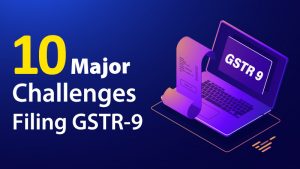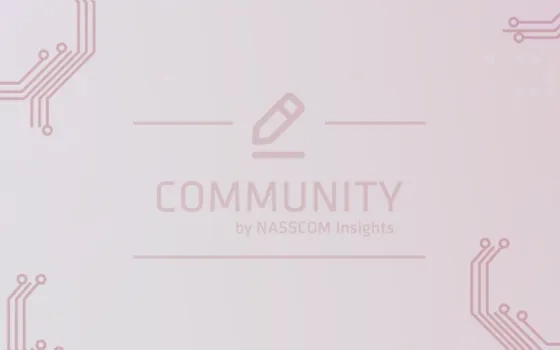In the GST Regime, filing an annual return by registered taxpayers and composition dealers is mandatory. And this annual return is known as ‘GSTR-9’.
On the basis of different kinds of taxpayers, there are, in total, four different types of annual returns, i.e. GSTR-9, GSTR-9A, GSTR-9B, and GSTR-9C.
However, in this blog, we will discuss mainly the 10 major challenges of filing GSTR-9.
Primarily, it is good to know, before stepping ahead, that following persons are not required to file GSTR 9 (as they are subject to file different Annual Returns) –
- Composition Dealers (as they are subjected to file GSTR-9A)
- Casual Taxable Persons
- ISDs
- Non-resident taxable persons
- TDS Collectors
The most specific difficulties in Filing of Annual GST Return are – difficulty in filing Details of 6A of Table No. III of GSTR-9, Outward Supply in Line No. 6C and 6D of Part-III of GSTR-9, Previous year Sales in Table No.5 of Part-I of GSTR-9A, tax paid as declared in returns filed during the Financial Year Table-9 of GSTR-9A, Mistake in Payment of RCM, While filing of GSTR-9 for the Regular Tax Payer, in Table No. 17 and 18 we required to provide the HSN No. of inward supplies which in value independently account for 10% or more of the total value of inward supplies and request to allow to make correction in inward and outward supply parties.
Let us discuss in detail.

1. Details of 6A of Table No. III of GSTR-9
Under Table 6A, the annual return demands the bifurcation of Input Tax Credit claimed between Inputs, Services, and Capital Goods, it is good to note that till date GSTR 3B was not asking for such kind of bifurcation and GSTR-3 has not been implemented yet. Hence, trade and industry have not maintained such kind of separate accounting records. And, the Accounting software is not designed in such a mode to provide the bifurcation. Thus, nearly after 2 years, such kind of bifurcation won’t be possible.
- So, it is advised to provide single-line Input Tax Credit information.
2. Details of 8A of Table No. III of GSTR-9
In table 8A of GSTR-9, it compares GSTR-2A along with ITC claimed in GSTR-3B. Therefore, you must note it that GSTR-2 was not functioning in the beginning, and excel export utility for GSTR-2A was made available only from August 2018, nearly after 6 months of the completion of the Financial Year, and thus, comparison of the data was totally impossible. Further, you must consider the Tweet by Hon. Finance Minister, that stated “GSTR-2A is only for the reference purpose only and there is no need to compare the same” trade was relaxed and have not made the comparison.
- So, it is advised to postpone this information for FY 2017-18.
3. Details in GSTR-9 are auto-populated
While going through the format of GSTR-9, either the figures are summed up from GSTR-1 or from GSTR 3B. There is no separate space to go with figures of books of accounts. It is good to note that GSTR-9 should contain adequate weight for books of accounts, and trade should be allowed to enter the details as per their books of accounts so that true and fair liability can be expressed.
- So, it is suggested to the Govt. to bring a new format for GSTR-9 with necessary modifications.
4. Making mistakes in Payment of RCM
During the first year of implementation, lots of mistakes were being identified on payment of RCM and claiming credit thereon. Basically, GSTR-9 takes the total of RCM shown in GSTR-3B, so there should be a suitable space to declare the RCM liability that was left out during the year in Annual return and suitable credit if available should be allowed to be claimed in GSTR-9.
- So, adequate action should be taken to clarify the issue.
5. Details of Outward Supply in Column 6C & 6D of Part-III of GSTR-9
Format of GSTR-3B contains a single line column wherein RCM was required to be declared. There was no differentiation as regards to the fact that whether the reverse charge is being paid under section 9(3) or 9(4). Furthermore, if the reverse charge was paid under a compulsory system, it had no connection whether the supplier was registered or not. Thus, trade has not prepared the requisite data.
- So, the new format should allow furnishing proper information of RCM Paid and Input tax credit claimed by the taxpayer.
6. If NEGATIVE FIGURE gets generated in Table No. 8D & 8J
As mentioned in point 8A where the Govt. had not the proper mechanism to start GSTR-2. There are cases where there is an excess claim of ITC than GSTR-2A whereas the purchases are genuine.
- So, you are requested to clarify every detail properly, and you should know the stand that is going to be taken by the Govt. in such cases.
7. Furnishing HSN Number mandatorily
While filing GSTR-9 for the Regular Tax Payer, in Table No. 17 and 18 we require to give HSN No. of inward supplies which in value independently account for 10% or more of the total value of inward supplies.
Here, it is good to know that relaxation has been given to Taxpayers having a turnover of Less than 1.50 Cr. and are not required to mention HSN No. of outward supplies. It has also been mentioned that to give HSN No. of Inward Supplies is mandatory in which the value independently accounts for 10% or more of the total value of Inward Supplies.
Whenever we write amount 10% or more of the total value of Inward Supplies online, GSTR-9 is not allowed to proceed online without giving quantity details, even though the annual income of taxpayers is less than 1.50 Cr.
It is good to note that many assets have not maintained quantity records and they are unable to furnish the data in the required columns. Government while launching GST had suggested that even 10th pass guy can file the GST returns, but it is not possible for a 10th pass guy to maintain GST Records along with quantity.
When we prepare GSTR-9 by using Offline utility given on the GST Website, GSTR-9 becomes ready to file online GSTR-9 without any details of HSN No. and the number of Inward Supplies. But, in Table No.18 it shows – (dash) in the details column. If we file this Offline tools prepared GSTR-9 in future GST Department will take action for not giving information of HSN No. of Inward Supplies which in value independently account for 10% or more of the total value of Inward Supplies.
- So, it is suggested to the GST Dept. to DELETE Table No. 17 and 18 from the GSTR-9
8. Permission to make correction in INWARD & OUTWARD SUPPLY PARTIES
Currently, there is no provision for revision of return. The only way to get the invoice details Amendment of the Return. So, it needs to be noted that even after the extension of the due date of claiming of such kind left out credits was being extended to March 2019. Yet the system was not allowing the drop down option for the year 2017-18 till a longer period. It needs to be mentioned that even today correction for invoices for B2C is not available for the month of July 2017. Henceforth, in the view of the above facts, it is clear that the system is not in its full pace with the changes and updating made/announced by the Government.
- So, the GST dept. is requested to allow the credits based on invoices and other relevant documents for the period 2017-18.
9. Details of sales for the Previous year in Table No.5 of Part-I of GSTR-9A
In the case of Some New Registered Assessee, when they go for filing GSTR-9A of Financial Year 2017-18 it is not allowed to file GSTR-9A of this year without putting any information in this table No.5. Interestingly, when they call on the helpline officials advised them to put 0.10 for filing of GSTR-9A.
- So, it is requested to the dept. to allow filing GSTR-9A without furnishing information at such level.
10. Details of taxes paid as declared in Returns filed during the Financial Year Table-9 of GSTR-9A
If a Composition Dealer was required to pay Interest or Penalty that he/she paid in the head of SGST and CGST both during the Financial Year 2017-18.
But for filing of GSTR-9A online we are getting information of half the amount of total paid under the head of SGST & CGST both. But, correction is only allowed in Column of PAYABLE, but no correction is allowed in Column of PAID. So, if changes are made in the Column of PAYABLE and no change in Column of PAID it will create balance payment liabilities.
- So, it is suggested that such issues should be removed immediately by the GST department.
Conclusion
GST is completely a techno-based and transparent system, yet above mentioned major issues are the biggest difficulties that are faced by the taxpayers. So, adequate actions should be taken by the Govt. And, taxpayers should also be aware of them and should take proper measures to skip such issues.









